| BrianRxm | The San Francisco Schools Bridge Medal | BrianRxm |
| San Francisco Public Schools Achievement Medal |
Awarded to Boys from 1879 to 1915
The Samuel Bridge silver medals were awarded to the top male students of San Francisco schools
from 1879 to 1915. They were usually known as "Bridge Medals."
The Denman Medal was a similar medal awarded to female students.
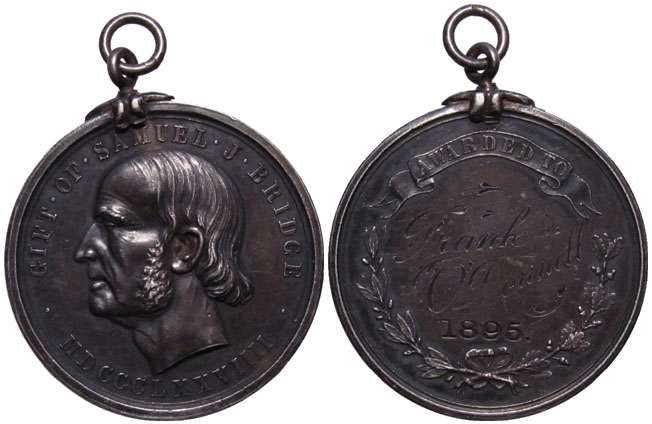
1. Samuel Bridge Medal awarded to Frank O'Donnell in 1895
Obverse: Samuel Bridge facing left, GIFT OF SAMUEL BRIDGE MLCCCLXXVIIII (1879)
Reverse: Scroll with AWARDED TO followed by engraved "Frank O'Donnell" and stamped "1895"
Reverse: Scroll with AWARDED TO followed by engraved "Frank O'Donnell" and stamped "1895"
Description:
The Samuel Bridge silver medals were awarded to the top male students of San Francisco grammar
schools from 1879 to 1915. The boys were usually graduates of the ninth grade of school and were
13 to 15 years old.
A similar medal, the Denman Medal, was first awarded in 1865 to graduates of the Denman Grammar
School, a school for girls only. In 1889 the Denman medals were awarded to the top San Francisco
school girls under the same rules as the Bridge medals for boys.
They were usually awarded in May of each year when the schools held graduation ceremonies.
Some were also issued in January to students who graduated at half-term.
The Bridge and Denman medals were last issued in 1915 and then discontinued.
The reason for ending the medal programs is unknown but may have been due to the war in Europe
which began in 1914 or the increase in the price of silver which was mostly stable in 1915
at 52 cents per troy ounce but began rising in November 1915.
By June of 1916 the price was 68 cents and by December 1916 the price was 80 cents.
Newspaper notices:
Names of medal awardees were published in the local newspapers, including the Daily Alta California,
San Francisco Chronicle, and the San Francisco Morning Call.
The Daily Alta California, May 30 1890:
The San Francisco Chronicle June 6, 1915 issue mentions the award of Bridge and Denman medals
that year but there are no further mentions of these awards.
SCHOOL MEDAL AWARDS
The Scholastic Proficiency of Prize Pupils Rewarded
In accordance with the custom which has been in vogue in the Public School Department of this city for several years past, the pupils who have attained the highest percentage in the annual examinations and the best general average during the year, have had their diligence rewarded with medals from the Bridge and Denman funds, established for that particular purpose.
The Scholastic Proficiency of Prize Pupils Rewarded
In accordance with the custom which has been in vogue in the Public School Department of this city for several years past, the pupils who have attained the highest percentage in the annual examinations and the best general average during the year, have had their diligence rewarded with medals from the Bridge and Denman funds, established for that particular purpose.
Design and production:
The medals had a generic design with the profile of Samuel Bridge on the obverse and a place for the
awardee's name on the reverse. They usually came with a loop or an attachment for a loop, possibly for wearing.
Obverse: Head of Samuel Bridge facing left / GIFT OF SAMUEL J. BRIDGE / MDCCCLXXVIIII [1879]
Reverse: Banner above and wreath / AWARDED TO in banner
In 1907 the banner around "AWARDED TO" was removed.
The medals were made of silver and were 34 mm in diameter.
Planchets of varying thickness were used and the medals weighed from 15 to 21 grams.
The medals were engraved with the recipient's name and usually stamped with the year awarded.
The medals were first struck at the Philadelphia Mint from 1879 to 1890.
In 1890 the US Mint stopped producing private medals and shipped the dies to San Francisco.
From 1891 to 1906 they were struck at Albert Kuner's office on Montgomery Street.
Kuner was a German goldsmith who arrived in San Francisco in 1849 and who engraved many of the
private gold coins for Moffat & Co., Wass, Molitor & Co., and Kellogg & Co.
Kuner died in January 1906 and later an earthquake destroyed his shop, records, and dies.
Robert Schaezlein, a San Francisco silversmith and badge manufacturer, created new dies and struck
the medals from 1907 to 1915.
Reverse: Banner above and wreath / AWARDED TO in banner
Samuel Bridge Biography:
Samuel James Bridge (June 1, 1809 to November 6, 1893):
He was born and died in Boston, Massachusetts, a member of a wealthy family there.
In 1841 he was an appraiser in the Boston Custom House.
In 1856 he was assigned to San Francisco as Appraiser General of the Pacific Coast.
He also was the Commissioner in charge of the building of the Customs House and US Mint.
He later donated a statue to Harvard University.
Samuel Bridge established "Bridge Medal Fund for Boys" in 1879.
The City and County of San Francisco Department of Public Schools publication Twenty-sixth
Annual Report of the Superintendent of Public Schools for the School Year Ending June 30, 1879,
page 310, "Bridge Medal Fund" noted:
He was born and died in Boston, Massachusetts, a member of a wealthy family there.
In 1841 he was an appraiser in the Boston Custom House.
In 1856 he was assigned to San Francisco as Appraiser General of the Pacific Coast.
He also was the Commissioner in charge of the building of the Customs House and US Mint.
He later donated a statue to Harvard University.
Samuel Bridge established "Bridge Medal Fund for Boys" in 1879.
A former resident of San Francisco, for many years holding the office of Appraiser-General under the
Federal Government, taking deep interest in the public schools and desirous of emulating the
distinguished example of [Benjamin] Franklin in founding medals for worthy public school boys,
made a handsome gift to the city, in the last school year, the circumstances and purposes of which
are fully explained in the following resolution, adopted by the Board of Supervisors:
Resolution No. 13,550
Whereas, Samuel J. Bridge, of Dresden, County of Lincoln, State of Maine, has donated the sum of $2,000, gold coin, unto the Mayor... to be used for the purchase of silver medals for distribution among the most meritorious boys of the Public Grammar Schools of San Francisco... [to be] an honorable mark of proficiency and distinction - "A Bridge Medal"
Whereas, Samuel J. Bridge, of Dresden, County of Lincoln, State of Maine, has donated the sum of $2,000, gold coin, unto the Mayor... to be used for the purchase of silver medals for distribution among the most meritorious boys of the Public Grammar Schools of San Francisco... [to be] an honorable mark of proficiency and distinction - "A Bridge Medal"
The March 26, 1962 San Francisco Unified School District (SFUSD) newsletter
San Francisco Public Schools Bulletin had an article on the Bridge and Denman medals.
Red Cross 'find' provides SFUSD history note
The Golden Gate Chapter, American Red Cross and the local Junior Red Cross have provided a
unique service for the San Francisco Unified School District by discovering a historic medal award.
The Denman Medal, which approximates the size of a silver dollar, was presented to girl students
between 1888 and 1915, ending during the World War I era.
The Samuel J. Bridge Medal, was awarded to outstanding boy graduates of S.F. grammar schools
between 1879 and 1915.
References:
Medals of the United States Mint: The First Century, 1792-1892 by R. W. Julian,
published by the Token and Medal Society (TAMS), 1977, lists these medals as number SC-52.
"The Denman Grammar School Medals of San Francisco" by Michael Wehner,
TAMS Journal September/October 2011 - Vol. 51, No. 5.
Miscellaneous articles:
The San Francisco Call of Friday, May 29, 1896, Page 11, published this article:
SCHOOL MEDALS MUST SOON GO
No More Souvenirs for Bright Girls and Boys
A SOURCE OF JEALOUSY
The Bridge and Denman Prizes Will Not Be Used Next Term
PRINCIPALS' PERTINENT VIEWS
A Luxury for Few - An Injury to Many - The Pupil at the Foot of the Class
It has been virtually determined by the educational Solons that the medals, which for so many years
past have been awarded to the public school children upon their graduation from the grammar grades
in recognition of excellence in scholarship and deportment, are more harmful than beneficial.
At the end of the term these glittering souvenirs that, with their blue ribbon attachments,
have been worn so proudly by so many bright and well behaved boys and girls will be in use no longer.
They are doomed and will soon be only a recollection of past days. Pride is not the sole feeling
associated with these medals, for their distribution as experience shows has been provocative also
of many heartaches and jealousies. Conformably to instructions from the Board of Education,
Superintendent Babcock recently sent a circular letter to primary, grammar and high school principals,
inquiring: "In your judgment is the presentation of medals advantageous?"
The answers received thus far from a score of principals, including several of the representative
schools, are emphatically in the negative.
"I am firmly of the opinion," says William H. Edwards of the Crocker Grammar "that
the distribution of medals for scholarship and deportment is an unalloyed evil, and for one I wish
the Board of Education would find some means of abolishing the nuisance. Those who win the medals
are those from whom no effort is necessary. Often the most deserving do not get them. Often they
are the cause of jealousy and bard feeling. Often the recipients obtain them by cheating and sharp
practice."
"Often those who do get them place no value upon them. I do not", writes James T. Hamilton
of the Lincoln Grammar, "regard medals as a proper incentive to study. Few pupils work for
them after the first two or three months. The rest of the class drops out of the race. Those that
do work for medals are the bright pupils, who need no such stimulus."
"No matter how fairly awarded, there are always some pupils, and often a few parents, dissatisfied."
Miss Clara M. Johnston of the Fairmount Primary thus tersely and strongly expresses her views:
"If medals are to be distributed, the number should be increased, giving the pupils who have made
great improvement an equal chance with those who are naturally bright or whose home surroundings
are such that they have every advantage. In my own neighborhood some of the brightest children
come from homes where parents are unable to read or write, where no daily paper is taken and where
there are few if any books in the house. Such pupils deserve medals before those ranking hither."
The system of medal distribution finds an out-and-out advocate in W. W. Stone of the
South San Francisco Primary, who says: "I believe in the medal system. Like all other stimulants,
medals should be given on the prescription of competent mental doctors. If there are men or women
or children whose powers of mind or body do not glow best under the motive energy of healthful
emulation I have never met them. Medals properly mixed and purely administered stir the sluggish
blood and impart activity to the halting brain."
Miss Agnes M. Manning of the Webster Primary and Mrs. Tiarah J. Mann of the Hawthorne Primary
also think that the medals should be retained and distributed impartially. Superintendent Babcock
says that medals ratify the pride of a few at the expense of the many, and should accordingly be
discontinued. The pupil at the foot of his class is, he holds, entitled to the utmost respect if
he be in earnest in his desire to learn and will, in the long run, be likely to come out a winner.
The San Francisco Call of Wednesday, March 31, 1897, Page 14 noted:
It is expected that the Denman medal fund of $3000 and the Bridge medal fund of $3000
will be made a part of the annuity fund, as they are no longer used for their original purpose,
owing to the fact that the awarding of medals to pupils engendered jealousy and ill-feelings.
The San Francisco Call of Friday, September 6, 1912 had this lost-and-found advertisement:
LOST - On Saturday. August 30, bridge medal, engraved on back FRANK C. TRACEY.
June 28, 1912. Return to F. C. TRACEY 136 Chenery St.; reward.
The San Francisco Municipal Record of Thursday, January 2, 1913, page 141 noted:
A communication from Harry Hook regarding the loss of a Bridge medal, and requesting duplicate
of same, was referred to the School Committee.
Henry Kugeler 1884:
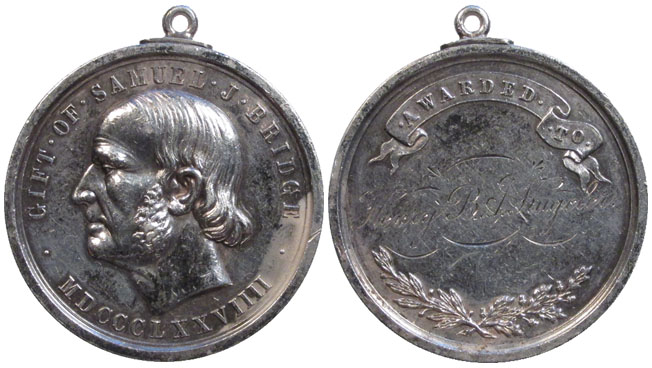
1. Samuel Bridge Medal awarded to Henry Kugeler in 1884
Silver, 34 mm, 18.15 gm
AWARDED TO / Henry B. A. Kugeler (no date)
The Annual Report of the Superintendent of Public Schools for the School Year 1884,
Bridge Medal Pupils 1884, notes that the South Cosmopolitan Grammar School awarded a medal to
Henry B. A. Kugeler.
The National Cyclopedia of American Biography, Volume 17, 1921, published by James T. White & Company
of New York in 1920, notes that:
KUGELER, Henry Behrent Albert, physician and surgeon, was born in San Francisco, Cal., July 30, 1870,
son of August and Meta (von Krog) Kugeler. His father, a native of Germany, came to America in 1856
and settled in San Francisco, where he was a merchant. Henry B. A. Kugeler received his preliminary
education in the grammar and high schools of San Francisco, which latter gave him the Bridge Medal.
After a year at the University of California he entered the Toland Medical College of that institution,
and was graduated in 1890 with the degree of M. D.
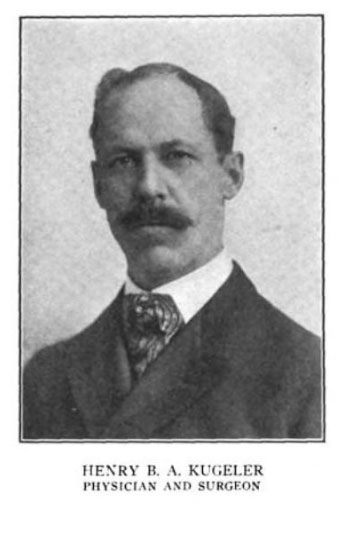
2. Dr. Kugeler's medical school graduation photograph
(University of California Medical School Announcement for 1920-1921)
Coors-Kugeler Wedding a Notable Event (Colorado Transcript dated Dec 31 1903)
Undoubtedly the most brilliant wedding in the history of Golden was that of Miss Louisa M. Coors
eldest daughter of Mr and Mrs Adolph Coors and Dr. Henry Kugeler of San Francisco which took place at
Calvary Church at high noon last Saturday, Dec. 26.
No pains or expense were spared in decorating the little church, and the result was most charming and
altogether startling in its effects. These decorations and the placing of them are said to have cost
nearly $81,000.
Dr. Henry Kugeler is a young gentleman of culture and refinement and has a brilliant future
in his profession. He has been a great traveler and it was in Europe last year that he first met
the young lady who is now his wife.
It was a case of love at first sight.
Friends of the family who were in attendance were royally entertained at the Coors home after the
ceremony, the newly wedded pair driving to Denver in the evening to start their elaborate
wedding tour after which they will settle down in San Francisco to a life which all hope will be
full of happiness and joy.
The San Francisco Blue Book; the Fashionable Private Address, Season of 1905,
a San Francisco society register, lists:
"Dr. HENRY KUGELER, 2 to 4 p. m. except Sundays, 813 Sutter St."
Dr. Kugeler was a member of the prestigious University Club.
Dr. and Mrs. Kugeler lived in San Francisco at 2210 Baker Street while waiting for their house,
a gift from Mrs. Kugeler's father Adolph Coors, to be built at 3636 Washington Street in Presidio Heights.
(the house sold recently for $15 million dollars)
Dr. Kugeler died in San Francisco on Dec 27, 1914 at the young age of 44.
He was survived by his wife and three children.
Grace Jackson 1890:
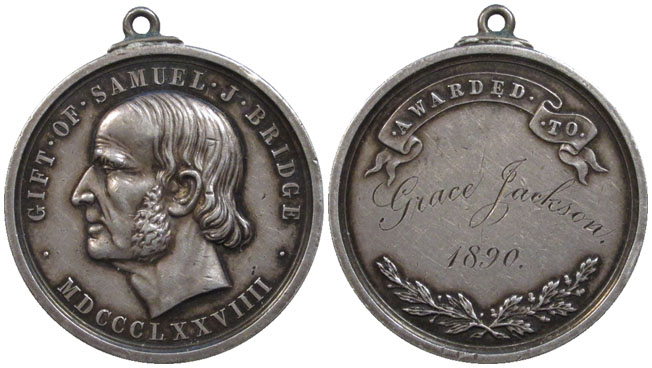
3. Samuel Bridge Medal awarded to Grace Jackson in 1890
Silver, 34 mm, 15.04 gm
AWARDED TO / Grace Jackson / 1890
The Report of the Superintendent of Common Schools of the City and County of San Francisco
for the Fiscal Year Ending June 30, 1890 lists the Bridge Medal Pupils, Tenth Award, May 1890.
Since Bridge medals were awarded only to boys, this medal is an oddity as Grace is a girl's name.
No "Grace Jackson" is listed but there is an "Oliver M. Jackson" listed as an awardee from the
Lincoln Evening School.
It is possible that the wrong name was engraved on the medal and that another medal was engraved
correctly and given to the recipient.
The Lincoln Evening School was located in the Hearst School Building at Hermann and Fillmore Streets.
The Transactions of the Society of Naval Architects and Marine Engineers, 1919,
lists an Oliver M. Jackson living at 1102 Kirkham St., Oakland (California).
Joseph Clark 1891:
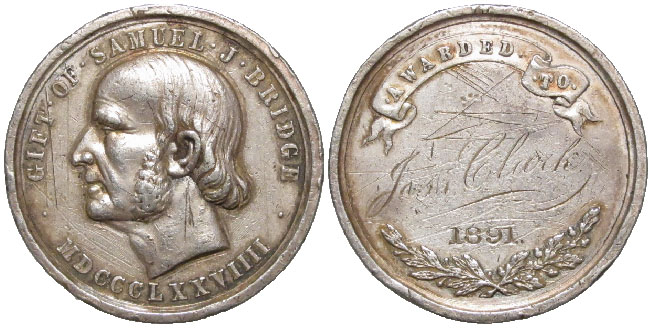
4. Samuel Bridge Medal awarded to Joseph Clark in 1891
Silver, 34 mm, 17.17 gm
AWARDED TO / Jos. Clark / 1891 (Joseph Clark)
This medal is missing the ribbon attachment loop and is heavily scratched.
The Report of the Superintendent of Common Schools of the City and County of San Francisco
for the Fiscal Year Ending June 30, 1891 lists a "Jos. Clark" as one of the Bridge Medal Pupils,
Eleventh Award, May 1891, at the Hearst Grammar School.
The Hearst Grammar School was located at Hermann and Fillmore Streets in San Francisco then.
It closed in 1976.
A Joseph Peter Clark filled out a World War I draft registration card.
He indicated that he was born April 1874, living on Polk Street, San Francisco, and was married to Lillian.
The birth year of 1874 meant that he was 17 years old when he was awarded the medal in 1891.
This was not unusual as many boys had to attend school and also work.
He and Lillian (or Lillie) had various addresses in San Francisco, in 1960 he was a boilermaker
for the San Francisco Naval Shipyard (Hunters Point) and lived in a house on Silver avenue.
It closed in 1976.
He indicated that he was born April 1874, living on Polk Street, San Francisco, and was married to Lillian.
Frank O'Donnell 1895:

5. Samuel Bridge Medal awarded to Frank O'Donnell in 1895
Silver, 34 mm, 18.74 gm
AWARDED TO / Frank O'Donnell / 1895
The San Francisco Call newspaper dated June 8, 1895 listed the graduates of the
Washington Evening School Ninth Grade, including "Bridge medalist" Frank O'Donnell.
Frank O'Donnell was born in San Francisco in 1880, lived all of his life in the city, and died in 1958.
He worked for various newspapers and then for the State of California as a civil servant.
Arthur Dangers 1897:
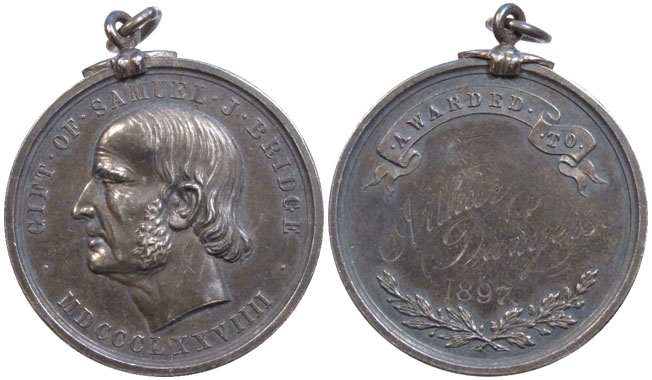
6. Samuel Bridge Medal awarded to Arthur Dangers in 1897
Silver, 34 mm, 17.15 gm
AWARDED TO / Arthur Dangers / 1897
A Chester Arthur Dangers was born February 11, 1884 in San Francisco.
He was the son of Dietrich Dangers and Hermine Grasse.
The birth year would make him the right age for a Bridge Medal (13-15 years old).
He was probably named after Chester Arthur, the United States President 1881-1885.
Arthur Dangers graduated in June 1900 from Lowell High School in San Francisco.
Lowell High School was the academic and university preparation high school for the city.
It appears he liked to be called "Arthur" or "Art."
A San Francisco Call Newspaper dated January 2, 1904 entitled "Entre Nous Cotillon is Merry Affair"
mentions that C. Arthur Dangers participated in the society event.
From information on relatives of Phyllis Mary Hinckley:
Arthur married Phyllis Mary Hinckley on August 13, 1926 in San Jose, California.
He was an electrical engineer and CPA. He was active in the Oriental Masonic Lodge and the Shriners.
After moving to Garberville he and Phyllis owned and operated a furniture store and motel.
He died on January 20, 1956 and is interred at Cypress Lawn Cemetery in Colma.
Arthur married Phyllis Mary Hinckley on August 13, 1926 in San Jose, California.
August Mehrtens 1897:
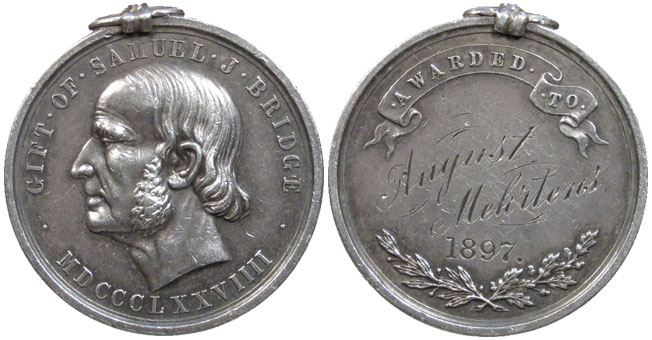
7. Samuel Bridge Medal awarded to August Mehrtens in 1897
Silver, 34 mm, 16.53 gm
AWARDED TO / August Mehrtens / 1897
The San Francisco Call newspaper of June 21, 1897, page 8, had an article on the graduates of the
Adams Cosmopolitan School mentioning a Bridge Medal to August Mehrtens.
Not much else can be found about August Mehrtens.
He would have been born around 1884 as the bridge medalists were usually 13 to 15 years old.
The San Francisco Call newspaper index has a couple of lines of interest:
A Henry Ernst August Mehrtens was married in 1876 to Meta and had a son born in 1884.
Noble Hamilton 1902:
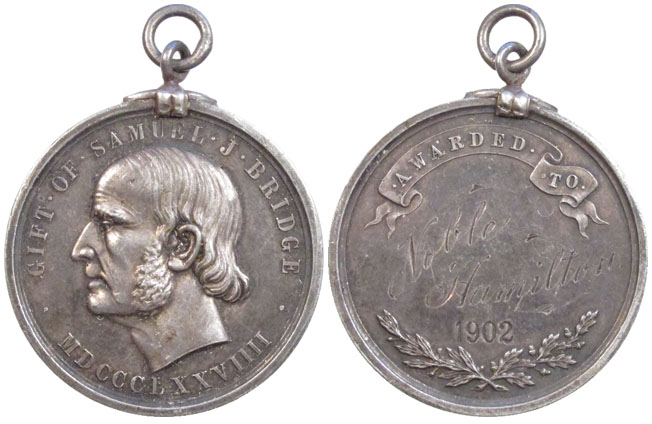
8. Bridge Medal awarded to Noble Hamilton in 1902
Silver, 34 mm, 20.21 gm
AWARDED TO / Noble Hamilton 1902
Noble Hamilton was a resident of San Francisco.
He was born in nearby Oakland on June 26, 1888, and died in San Francisco on May 9, 1941 at the age of 52.
He grew up at 1770 Pacific Avenue with his father Edward H. (Pop) Hamilton, a newspaperman and political reporter,
and his mother Fanny. He had a brother and a sister.
Noble Hamilton was a grandson of pioneer the Reverend Laurentine Hamilton for whom Mount Hamilton is named.
Noble Hamilton attended San Francisco public schools and graduated from the University of California at Berkeley in 1911.
He led the Class of 1911 Senior Pilgrimage to the Hearst Mining Building.
He appeared in a student play on March 31, 1911 where:
On May 16, 1911, Noble Hamilton was awarded a degree in Jurisprudence (Law).
Noble Hamilton, as Bob Madden, not only won the hearts of all the women in the cast, but of those in the audience as well.
Noble Hamilton married Elizabeth Bull sometime after graduating from college.
His daughter Elizabeth (Betty) was born on August 28, 1918 and his son Noble Hamilton, Jr. was born on December 20, 1921.
The San Francisco society register Blue Book, published by Charles C. Hoag of 340 Sansome Street, San Francisco,
editions for 1918 and 1921 list Mr. and Mrs. Noble Hamilton at 2687 Union Street.
Obituary:
Noble Hamilton, Pacific Coast advertising man and son of the late San Francisco political writer,
Edward H. (Pop) Hamilton, died yesterday in Stanford Hospital after an illness of 10 months.
He was born in Oakland June 26, 1888, was graduated from the University of California.
At the time of his death he was Pacific Coast representative for Outdoor Advertising, Inc.
Hamilton leaves a widow, Mrs. Elizabeth Hamilton, a daughter Betty, and a son Noble Jr.
He resides at Cypress Lawn Memorial Park in Colma, California.
Mervyn Wehe 1902:
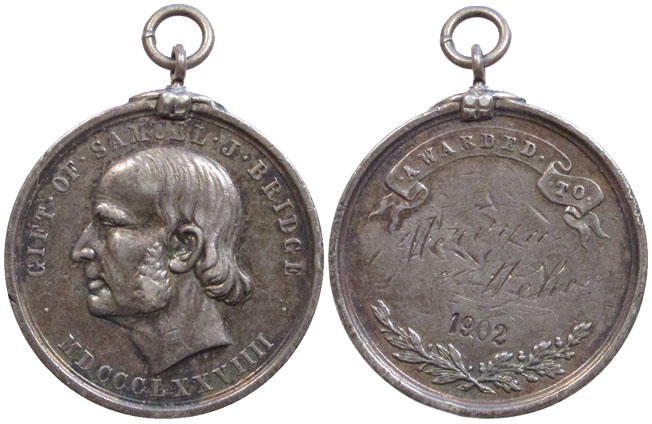
9. Samuel Bridge Medal awarded to Mervyn Wehe in 1902
Silver, 34 mm, 20.14 gm
AWARDED TO / Mervyn Wehe / 1902
The recipient's name has been somewhat scratched out and is difficult to read.
The recipient's name has been somewhat scratched out and is difficult to read.
Mervyn Wehe was born in San Francisco, California, on March 21, 1889.
His father was San Francisco resident Frederick P. Wehe (1864-1908).
Mervyn married Gertrude Langstaff, born 1892, the daughter of William J. Langstaff, the vice-president
of the Dodge, Sweeney & Co., a wholesale dealer of supplies for grocery stores.
Mervyn was a salesman for the company.
Mervyn was a member of the Native Sons of the Golden West (NSGW) fraternal organization.
From the NSGW newsletter The Grizzly Bear, June 1918 Page 32:
Official Directory of Parlors of the N.S.G.W. San Francisco City and County
Golden Gate, No. 29 - Mervyn Wehe, Pres; Adolph Eberhart, Sec. 188 Carl st., San Francisco;
Mondays: N.S.G.W. Bldg., 414 Mason st.
The Native Sons Building at 414 Mason Street, San Francisco, is still standing.
Mervyn Wehe and Gertrude Wehe both died in October 1918 from the "Spanish Flu".
From The Retail Grocers Advocate, San Francisco, November 1 1918, Page 7:
Langstaff Family Stricken
William J. Langstaff, 422 Belvedere Street, vice-president of Dodge, Sweeny [Sweeney] & Co. is
waging a grim battle against the Spanish influenza which has descended upon his home with all
its fury, sweeping away two members of the family and laying low three others.
A daughter, Gertrude Langstaff Wehe, and her husband, Mervyn Wehe, a popular salesman for
Dodge, Sweeney & Co., both succumbed to the disease, the young wife dying on the afternoon of
the 21st and the husband on the following morning.
They left three children, the oldest of whom, Dorothy, age 5, is now fighting for her life against the
relentless malady that has made her and her brothers orphans.
William J. Langstaff and another daughter, Dorothy Langstaff, an aunt of the little girl mentioned
above, also have the influenza and are in a serious condition.
Mervyn Wehe left two sons, Mervyn Wilson Wehe, and William Gordon Wehe.
Mervyn Wilson Wehe was born in 1914, graduated from the University of California at Berkeley in 1937
and died in October 2000. William Gordon Wehe born in August 1916 and died December 1989.
It is not known if Mervyn's daughter Dorothy Wehe "age 5" survived the disease.
Frank J. Hansen 1905:
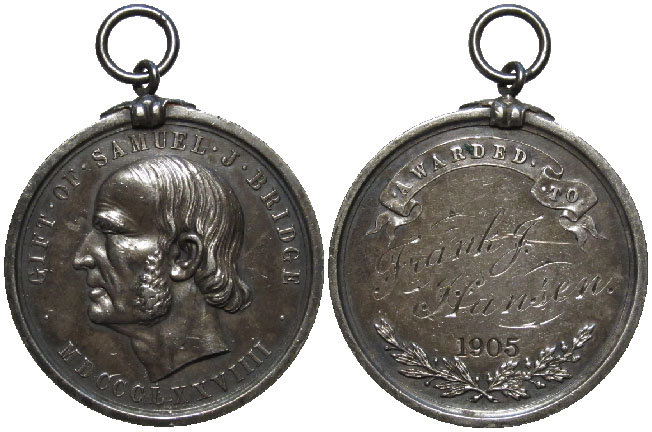
10. Samuel Bridge Medal awarded to Frank J. Hansen in 1905
Silver, 34 mm, 20.97 gm
AWARDED TO / Frank J. Hansen / 1905
The San Francisco Call newspaper of June 30, 1905 had an article on the graduates of the
Humboldt Evening High School. Frank J. Hansen was listed as a Ninth Grade graduate.
DIPLOMAS ARE GIVEN TO MANY PUPILS
Closing Exercises of Schools Largely Attended
Efforts of Graduates Receive Applause
Those who received medals were:
Bridge medal - F.C. Brindupkey, Frank J. Hanson (sic), William Conry; Denman medal, Rosa Gluck.
In 1910, a Frank J. Hansen was listed as a carpenter living at 1950 Lombard Street, San Francisco.
John Calder 1908:
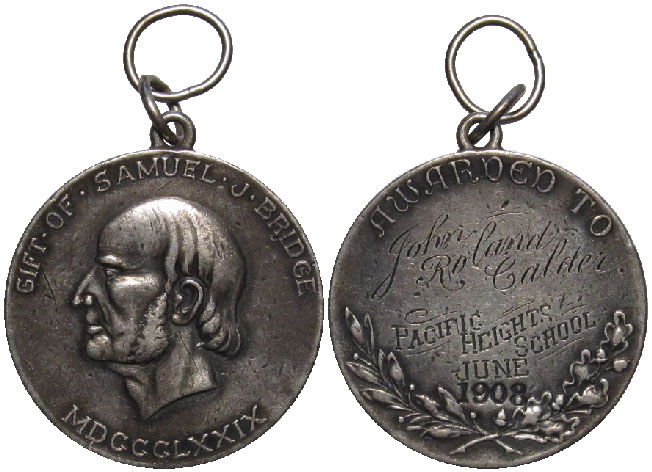
11. Samuel Bridge Medal awarded to John Roland Calder in 1908
Silver, 34 mm, 20.79 gm
AWARDED TO / John Roland Calder / Pacific Heights School / June 1908
This medal was struck by Robert Schaezlein's company and has his new design.
The San Francisco Call newspaper of June 18, 1908 had an article on the graduates of the
Pacific Heights School.
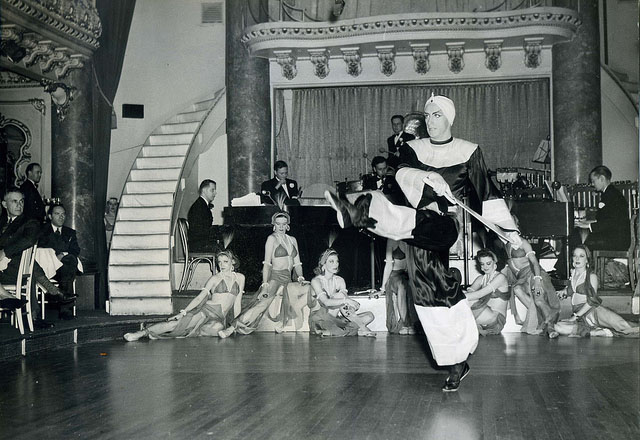
Photographed by Roland Calder, March 19, 1940
Marian died in 1969, Roland moved to Winters, a small town near Napa, and died there in April 1981.
Roland and Marian Calder are interred at a cemetery in Winters.
PACIFIC HEIGHTS SCHOOL
Many Hear Program by Graduates and Chorus of Students
Graduating exercises were held at Pacific Heights School, Miss A. M. Stincen principal,
yesterday afternoon in the school building in Jackson street.
Miss F. M. Bliven's class - Bridge medals: Roland Calder, Baltzer Petersen.
John Roland Calder was born on May 29, 1893 in Malden, Massachusetts.
His family moved shortly thereafter to San Francisco.
He frequently used the name "Roland Calder."
He attended the University of California at Berkeley, majoring in Agriculture.
He was a member of the Camera Club and the Rifle Club.
He graduated with a degree in agriculture in 1917.
Roland was in a military training program and received a commission as an Army Lieutenant in 1916.
His military record shows no active service in World War I.
Sometime before 1922 Roland married Marian Stiltz, also a 1917 University of California graduate.
She was a trained singer, a mezzo-soprano, and sang for women's groups in the area.
Roland and Marian lived in Berkeley and then in Oakland, California.
Roland worked mostly in photography and later as a public school teacher.
The couple did not have any children.
He was a salesman for the Trainer & Parsons Optical Company at 228 Post Street, San Francisco.
He was a member of several photography and camera clubs and entered photographs in contests.
In 1929 Roland filmed employees of the Ransohoffs women's clothing store as they moved
from 225 to 259 Post Street. He may have filmed a comedy there at the same time.
Both films, "Last Scenes of 225 Post" and "Just Any Day at Scandalhoffs" can be found online.
Roland Calder took this photograph in 1940 at a San Francisco nightclub:

12. "Turban Power"
The Music Box, 859 O'Farrell St., San Francisco, CaliforniaPhotographed by Roland Calder, March 19, 1940
Roland and Marian Calder are interred at a cemetery in Winters.
Frank Dowling 1910:
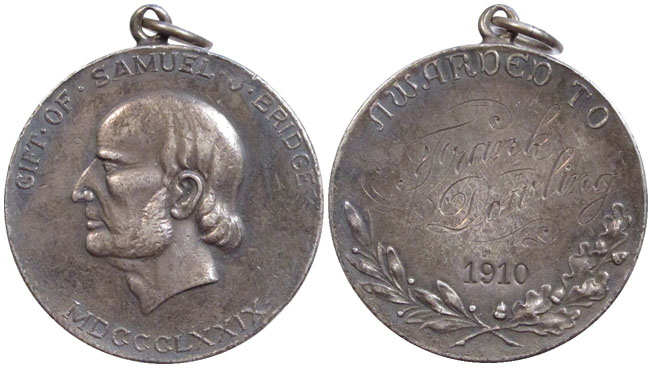
13. Samuel Bridge Medal awarded to Frank Dowling in 1910
Silver, 34 mm, 20.50 gm
AWARDED TO / Frank Dowling / 1910
The San Francisco Call newspaper of June 11, 1910 had an article on the graduates of the
Everett School.
The news article listed graduates of several city schools and listed their Bridge Medal awardees.
There were no medalists listed for the Everett School but it is safe to assume that, as Frank Dowling
was listed as the valedictorian, he would have received the medal.
Not much else can be found about Frank Dowling except for a Frank C.Dowling who lived at
280 Dolores Street in 1910, around a tenth of a mile from the school.
STUDENTS BEGIN JOYS OF HOLIDAY
Happy Release From Books and Classrooms During the Vacation Season
Everett Grammar
Several hundred persons attended the Everett Grammar School exercises at the graduation of 38 pupils.
There were several class songs and the valedictory was by Frank Dowling.
The graduating class was addressed by the Rev. H. W. Page and Principal Selden Sturges.
Jack Penderboy 1913: (Jack Pedeuboy)
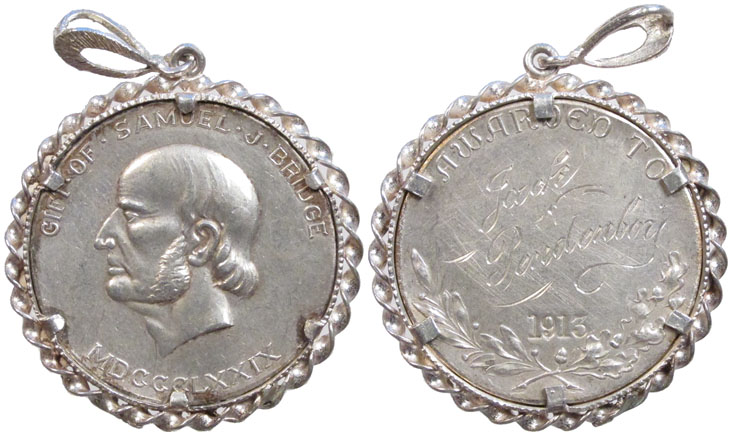
14. Samuel Bridge Medal awarded to Jack Penderboy in 1913
Silver, 42 mm, 24.40 gm
This medal is mounted in a silver bezel and the above measurements include the bezel.
The plain medals are 34 mm in diameter and weigh around 18 grams.
AWARDED TO / Jack Penderboy / 1913
The plain medals are 34 mm in diameter and weigh around 18 grams.
Warren Marston 1914:
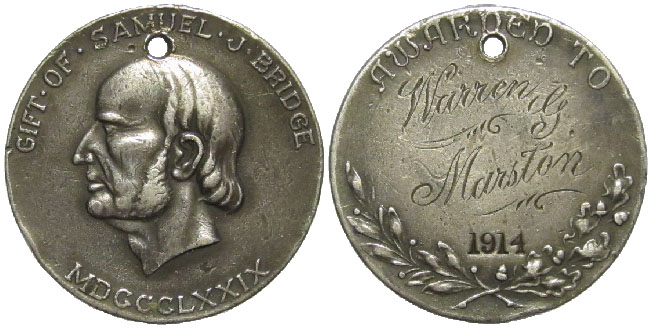
15. Samuel Bridge Medal awarded to Warren G. Marston in 1914
Silver, 34 mm, 18.14 gm
AWARDED TO / Warren G. Marston / 1914
This medal has been roughly treated, is missing the loop, and has a hole drilled in it.
Warren Marston does not appear in the June and December 1914 San Francisco Chronicle newspaper or
San Francisco Examiner lists of graduates.
A "Warren Galbreathe Marston" was born on November 25 1899 in Chicago, Illinois.
He lived in San Francisco in 1910 according to the US Census, and attended Lowell High School,
a college preparatory school.
He attended the University of California in Berkeley as a pre-medical student.
He graduated from the St. Louis University School of Medicine in 1928.
He married Minnie E. Thomas in 1927.
Dr. Warren G. Marston signed a death certificate in St. Louis on Jan 10, 1937.
He is listed in the 1940 US Census as living in St. Louis and working as a surgeon.
Dr. Warren G. Marston, F.A.C.S., F.I.C.S. of St. Louis University School of Medicine, St. Louis
was listed as a member of the International College of Surgeons, United States Chapter, in 1949.
(F.A.C.S. is Fellow of the American College of Surgeons and F.I.C.S. is the International College)
Dr. Marston died in February 1965 in St. Louis, Missouri.
Kenneth May 1915:
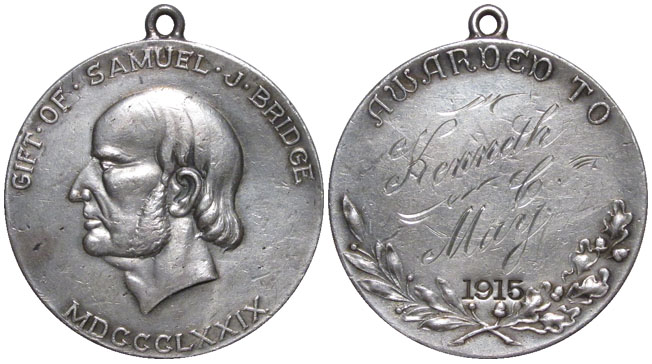
16. Samuel Bridge Medal awarded to Kenneth C. May in 1915
Silver, 34 mm, 18.32 gm
AWARDED TO / Kenneth C. May / 1915
This is the last year that Bridge medals were awarded.
A "Kenneth C. May" was born on December 12, 1901 in Auburn, California.
He lived in San Francisco later.
He was a First Lieutenant in the California National Guard from 1925 to 1927.
He is listed in the 1930 US Census as living in Portland, Oregon, married to Edith, and working as a
manager with a stock and bond company.
Later he worked for the US Department of Agriculture in San Francisco.
By the 1960's he was retired and living with Edith at 1950 Gough Street, a very swank apartment.
Kenneth May passed away in November 1977.
Loton Wells 1915:

17. Samuel Bridge Medal awarded to Loton Shofner Wells in 1915
Silver, 34 mm, 20.46 gm
AWARDED TO / Loton Shofner Wells / 1915
Loton Shofner Wells was born as Loton Dutreaux Wells in San Francisco, California on June 6, 1901.
His father was William Shofner Wells (1870-1962) who was in the fire-insurance business in
San Francisco.
He was descended from a Colonel Loton Shofner who was born in North Carolina 1813 and later
moved to Tennessee.
Stanford University:
Loton attended Stanford University in Palo Alto, California and graduated in 1924.
Loton was a member of the El Tigre Eating Club.
The Stanford Eating Clubs were an alternative to fraternities but without the discrimination and hazing.
The Stanford Quad Annual 1925 (yearbook) contained a photograph of club members.
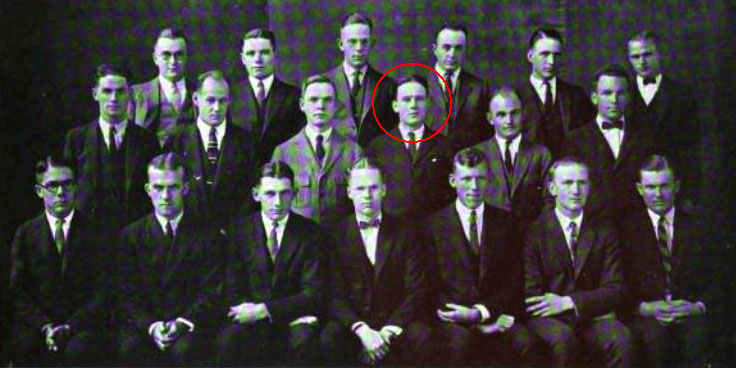
18. Photograph of El Tigre Club members with Loton Wells circled
The Stanford Quad Annual 1925 (yearbook) has an entry for Loton Wells:
Loton Dutreux Wells, San Francisco, Law
El Tigre, Branner Club, Christian Science Society, Vice-President (4), Euphronia Debating Society,
Y.M.C.A., Triangular Debate Team (4), Business Staff, Daily Palo Alto (1)
University of California Law School:
Loton attended the University of California School of Jurisprudence (Now UC Berkeley School of Law)
and graduated in 1926 with a law degree.
The University of California Bulletin School of Jurisprudence Announcement for 1926-1927,
published May 1928, has a list of Second Year Law Students including:
Wells, Loton Dutreux, A.B. (Stanford University) 1924, San Francisco, 2111 Union St. S F West 7165
Later life:
The Stanford Illustrated Review January 1927 Alumni Association of Stanford University noted that
Loton Wells has moved from San Francisco to Los Angeles and is working for Ellis & Vickers (a law firm).
In 1923 Ellis & Vickers was located at 1219-22 Bank of Italy Bldg, Los Angeles.
Loton Wells worked as an attorney specializing in Workmen's Compensation cases.
The United States Supreme Court Journal for 1939, Monday June 3, 1940, Page 265
lists Loton Wells, of Los Angeles, Calif.; admitted to practice.
In 1941 he appeared in a Life Magazine advertisement for hearing aids.
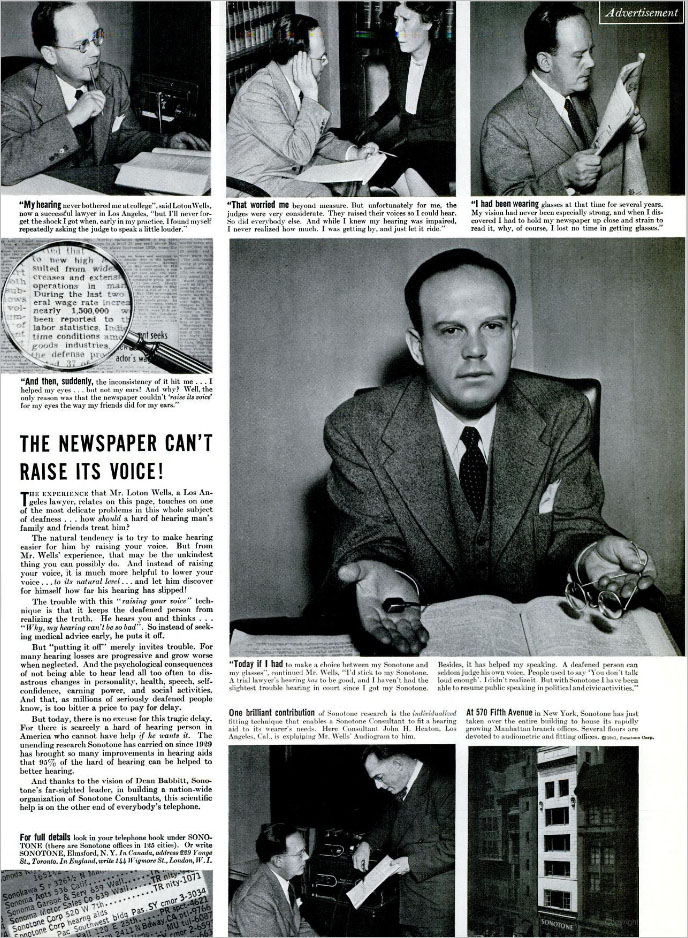
19. Life Magazine September 15 1941 advertisement featuring attorney Loton Wells
Loton Wells apparently never married as there is no information on a spouse or children.
It is unlikely that he ever served in the military due to his hearing problem.
Loton Wells died in Santa Barbara, California, on June 21, 1988.
It is unlikely that he ever served in the military due to his hearing problem.
Blank Bronze Medal:
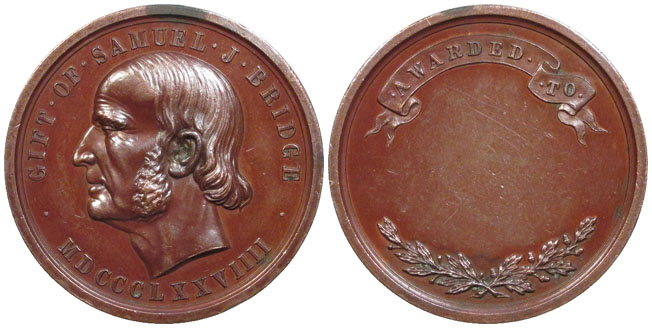
20. Bridge Medal Blank Bronze
Bronze, 34 mm, 19.12 gm
This bronze medal has no year or inscription and has the original US Mint reverse banner.
It might be a US Mint trial piece or pattern or possibly was struck by Albert Kuner
to test the dies received from the Philadelphia Mint.
Denman Medal - Frances Mabel Reed 1899:

21. Denman Medal awarded to Frances Mabel Reed in 1899
Silver, 34 mm, 17.64 gm
AWARDED TO / Frances Mabel Reed 1899
Not much information could be found about Frances Reed.
The San Francisco Call newspaper dated June 17 1899 noted that a Maybelle Reed graduated from
the Hamilton Grammar School, she was in Miss Strauss' class.